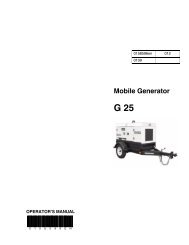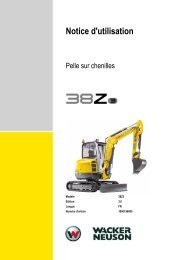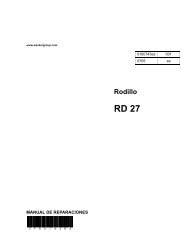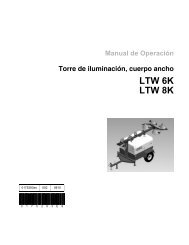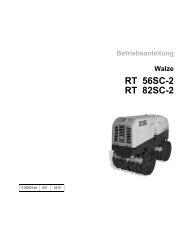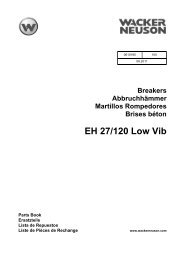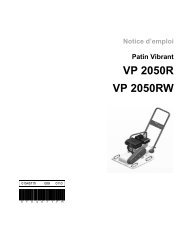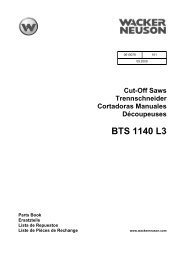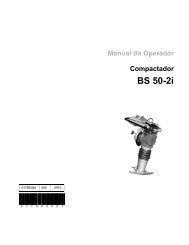Repair Manual Mobile Generator - Wacker Neuson
Repair Manual Mobile Generator - Wacker Neuson
Repair Manual Mobile Generator - Wacker Neuson
Create successful ePaper yourself
Turn your PDF publications into a flip-book with our unique Google optimized e-Paper software.
<strong>Mobile</strong> <strong>Generator</strong> <strong>Repair</strong> John Deere Engines with ECU<br />
6 John Deere Engines with ECU<br />
6.1 John Deere Engines With ECU—Background<br />
John Deere engines with electronic control systems are used on<br />
<strong>Wacker</strong> <strong>Neuson</strong> generator models G 70, G 85, and G 120. The<br />
electronic control system consists of:<br />
Engine Control Unit (ECU): the computer which controls fuel and<br />
the ignition system.<br />
The following sensors: oil pressure, coolant temperature, fuel<br />
temperature, manifold air temperature, crank position, and<br />
speed.<br />
Fuel pump control solenoid.<br />
Manifold air heater.<br />
The electronic control system serves as a governor by controlling the<br />
fuel to the engine. It does so by controlling the engine’s injection pump<br />
control valve through a proportional solenoid. In doing so, fuel is<br />
delivered according to engine conditions, in precise amounts, and at<br />
the precise time in relation to piston position.<br />
The ECU communicates with the Engine Control Module (ECM)<br />
mounted to the generator’s control panel through a Controller Area<br />
Network (CAN). The wiring between the controllers forms a bus<br />
(physical electrical interface where many devices share the same<br />
electrical connections). Diagnostic tools available from John Deere<br />
can plug into the CAN bus to assist in troubleshooting the operation of<br />
the engine. The ECM controls the engine up through engine start<br />
(cranking). Once started, the ECU controls the running of the engine.<br />
The ECU has diagnostic abilities and shares engine diagnostic<br />
information through codes which are displayed on the ECM display<br />
screen. These diagnostic codes are referred to as “SPN/FMI” codes:<br />
Suspect Parameter Number (SPN) and Failure Mode Identifier (FMI).<br />
SPN/FMI codes are conveyed in a two-part code number. The SPN<br />
typically contains between two and four digits and is the first number<br />
of the code. The FMI contains one or two digits and is the second<br />
number of the code. For example, if the ECM displays “SPN/FMI 100.<br />
4”, The SPN “100” indicates a condition with the engine oil. FMI “4”<br />
indicates that the engine oil pressure input voltage is lower than the<br />
sensor’s specification—a condition associated with a disconnected oil<br />
pressure sensor. There are many such SPN/FMI codes. See the John<br />
Deere service manual for more information.<br />
wc_tx001067gb.fm 53




